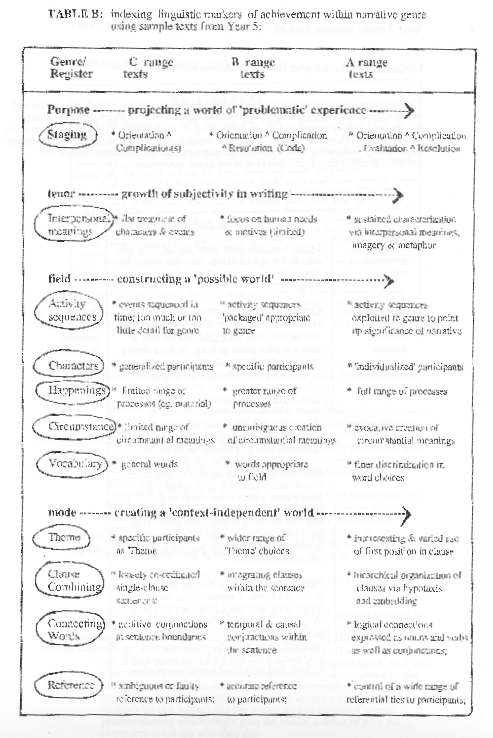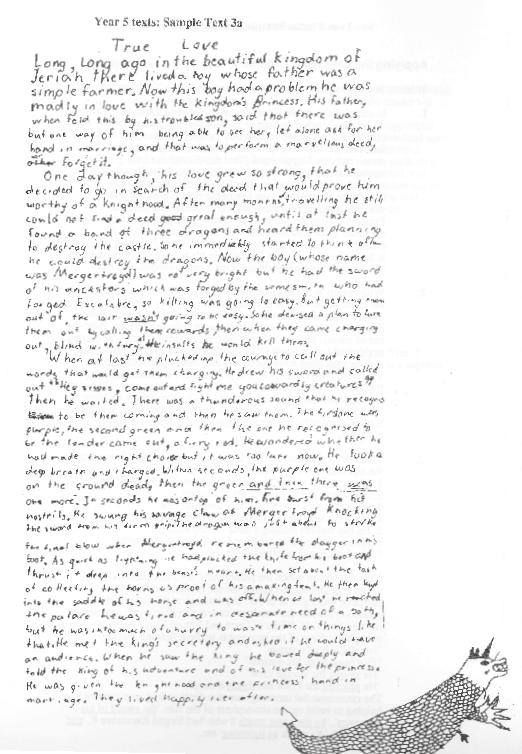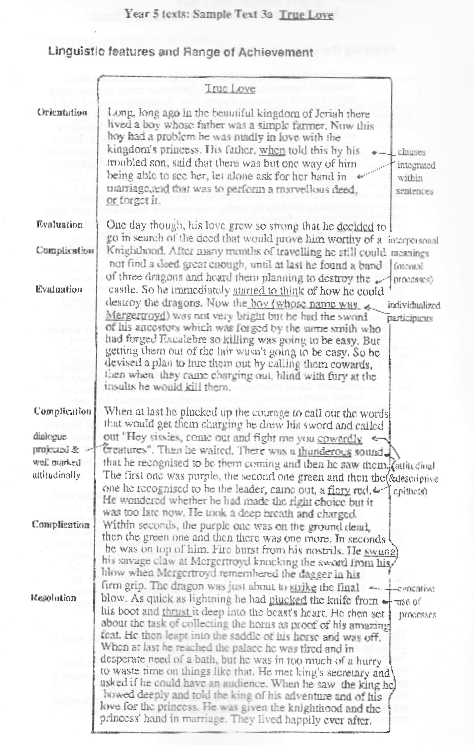What are some story genres and what are they used for ?
Read the 3 texts which follow and talk about the things they have in common and the things which make them different from each other.
Story-type 1: recount
On Saturday we had a netball match in Marrickville. I got up around 8:00 and had some breakfast. Maria and Nicky joined me at the bus stop. They were a bit late but we didn’t have to wait too long. One of the boys in our neighbourhood almost went under the bus taking us to netball. The bus driver was really angry with him. When we got to the field the rest of the team had already arrived. It was a close game, but we won 4-3. Maria got two goals. We stopped at Macdonald’s on the way home to celebrate. Then we went over to Nicky’s to watch videos. A pretty eventful day !
Story-type 2: narrative
Maria, Nicky and Tatiana were on their way to netball, waiting for the bus. While they were waiting they saw a group of boys on BMX bikes racing along the footpath. The rider in front was being chased by the others who appeared very determined to catch him. As the girls watched, the frightened boy raced towards them. Then just as he drew near the onlookers their bus appeared around the comer. The boy’s pursuers caught up and gave him a shove. The girls watched in horror as the boy on the BMX ran over the curb straight into the side of the bus! As fast as they had appeared the ones chasing the boy took off. The three girls were shocked: they were sure the boy on the bike had been killed. Tatiana raced to the side of the bus and to her great relief saw that the boy was sitting up and rubbing his head as if he was in a daze. Standing over him was the bus driver talking loudly about the importance of helmets. She felt sorry for him. As if almost having a fatal accident wasn’t awful enough he then had to endure a lecture on road safety from a frightened bus driver on top of that.
Story-type 3: news story
A young boy escaped fatal injury when a bus driver swerved to avoid a victim of a BMX bikie gang chase at Leichardt yesterday. The youth, aged 10, narrowly escaped death as he careered into an oncoming bus attempting to escape from a gang of other youths on bikes.
The boy’s bike was damaged but the boy emerged unharmed, except for minor head injuries. He is at present recovering at home with his family. Following the incident, the bus driver, Neil Simpson (39 of Annandale), reported the accident to the police at Leichhardt following an angry interchange with the other members of the BMX gang whom he later pursued in his bus. None of the gang were wearing safety helmets and all were travelling at a dangerous speed on a major public thoroughfare.
“This irresponsible sort of behaviour is typical of the youth of this neighbourhood” said the driver later. “Something has to be done to improve the safety of our roads. The schools should be running proper road safety programs. This matter will be taken as far as the minister if nothing is done in the local schools about it.”
Three Types of Story
The recount deals with a sequence of events. The speaker or writer’s focus is very much on the temporal succession of events – the fact that this event followed that one and so on. Interpersonal meanings, which show the significance of the events, are usually only scattered through the middle stages of the text. The stages can be represented as:
| Orientation A Events n A (Re-orientation) |
Note: The notation A means ‘is followed by’; brackets means ‘the stage is optional’; n means ‘the stage can be repeated any number of times’.
The Narrative deals with events that are problematic and which lead to a crisis or turning point of some kind. The complicating events are usually resolved by a main character. Aspects of setting, details about characters and situation are important for orienting the reader/listener. Where the writer/speaker attempts to bring out the significance of the events in a particular stage is an ‘Evaluation’. In the final part of the narrative there is some kind of ‘Resolution’ stage where the problems or complicating events which were ‘set up’ in the earlier part of the text are resolved for better or worse. The stages of Narrative can be represented as:
| Orientation A Complication A Evaluation A Resolution A (Re-orientation or Coda). |
The News Story deals with events that are regarded as ‘newsworthy’ in some way. If the events are about a disaster of some kind, then the first stage is the ‘Crisis’. But the news story may be about the marriage of a well-known film star or media personality. This too, can be regarded as a ‘Newsworthy Event’. Following details about ‘who’, ‘what1, ‘where’ and ‘when’ in the first stage, the writer gives more ‘Background Events’ and usually includes a comment from a ‘Source’ relevant to the events. The Source may be quoted directly or reported. The ‘Source’ may be a politician, a policeman or an onlooker. It is possible to say that the news is not so much about what happened as about ‘who says what happened’. The stages of a news story can be represented as:
| Newsworthy Events A Background Events A Sources |
Assessing Stories

A Successful Year [Grade] 5 Narrative


Applying the Linguistic Criteria
This text is a very successful example of narrative for a Year 5 writer.
- In terms of the genre the writer has exploited all the relevant stages of the genre including that of ‘Evaluation’ (e.g. ‘Now this boy had a problem … ‘). The writer also uses of interpretative comments to focus on the motives and needs of the characters – especially the main character Mergertroyd (‘One day though his love grew so strong that he decided to…’). Also in terms of the ‘Resolution’ stage of the narrative, the writer has constructed a far more satisfying conclusion to the hero’s problems. It is Mergertroyd who is responsible for the deed that wins him his goal (the Princess). Also the writer is obviously comfortable enough with the genre to be able to ‘spoof it in some amusing ways; for example we learn that ‘Mergertroyd was not very bright’, that he is basically cowardly but inventive in his baiting of the dragons, that he does not worry about taking a much needed bath etc.
- With regard to the tenor, the dialogue is well framed, set off from the event sequence and well marked attitudinally (though infrequently used). Furthermore it is in the planning of the deed that the interpersonal meanings are most fully established. Note the use of mental process clauses like: ‘He decided to go..’, ‘he started to think of how he could destroy the dragons’, ‘he devised a plan’ and ‘he wondered whether he had made the right decision’ etc. The events become significant for the reader because they are framed in terms of the needs and motives of a character. The writer has exploited the possibilities of descriptive epithets in building up the possible world; for example in nominal groups like ‘a simple farmer’, ‘cowardly creatures’, ‘thunderous sound’, his savage claw’ etc.
-
In terms of field the activity sequences are exploited to point up the significance of the events for Mergertroyd:
Mergertroyd has a problem of his love for the Princess.
His father, the King presents a solution.
Mergertroyd’s love grows too strong to bear.
He sets out to perform a deed to win the Princess.
He has trouble finding a deed worthy enough.
He hears three dragons planning to destroy the castle.
He devises a plan to trap them etc.Note the way in which the participants are individualized. The writer is beginning to explore the use of characterization in narrative writing. It is in the exploitation of the full range of process types that the writer constructs a mythic world reminiscent of tales like T. H. White’s “Once and Future King”. Note the metaphoric force of the processes in the following clauses:
“He plucked up courage”
“Fire burst from his nostrils”
“He swung his savage claw”
“He plucked the knife and thrust it deep”.The circumstantial meanings are also dealt with in an evocative way helping to build up the atmosphere of the tale: ‘the sword of his ancestors’, ‘by the same smith II who had forged Excalebre II’, ‘out of the lair‘, ‘As quick as lightning‘ etc.
- In terms of the written mode the writer has command of the textual resources necessary to create a possible world for the reader via text alone. S/he understands the requirements of a ‘context-independent’ text. Note the competent use of hypotaxis and embedding in (“His father I when told this by his troubled son I said that there was but one way of him being able to see her, || let alone ask for her hand in marriage || and that was to perform a marvellous deed || or forget it ||”. The writer has integrated both direct speech and reported speech and also made consistent use of clauses projecting ideas as well as speech throughout the text. S/he has control of a wide range of referential ties like the following: A boy – his troubled son – Mergertroyd – he etc.
This text is in the top range of achievement for narratives in the Year 5 class. Along the dimensions of genre, tenor, field and mode it is a superior achievement for a Year 5 writer.
Macken, Mary, Mary Kalantzis, Gunther Kress, Jim Martin, Bill Cope, and Joan Rothery. 1990. A Genre-Based Approach to Teaching Writing, Years 3-6, Book 3. Writing Stories: A Teaching Unit Based on Narratives About Fairy Tales. Sydney: Directorate of Studies, N.S.W. Department of Education, pp.19, 18, 85, 93, 92, 94-95.
